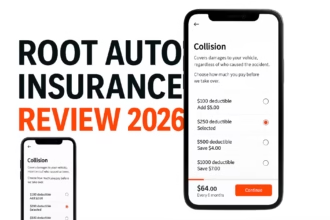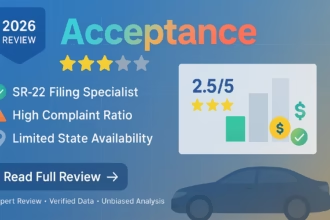The $3,000 Mistake 73% of Americans Make Every Year

Sarah from Phoenix thought she’d struck gold when she found car insurance for just $89 per month, half the price of her previous policy. Six months later, after a minor fender-bender, she discovered her “bargain” policy would cost her $2,847 out of pocket due to high deductibles and limited coverage. She’s not alone: 73% of Americans choose insurance based primarily on price, according to the Insurance Information Institute, often paying significantly more when they actually need coverage.
Compare Real Insurance Rates Now →
The truth about cheap insurance isn’t what most people expect. While Americans spent an average of $1,771 on car insurance in 2024 (up 26% from 2019), those who chose the cheapest policies often ended up paying far more when claims arose.
Why Cheap Insurance Became America’s Expensive Problem
The rise of budget insurance carriers has created a perfect storm of consumer confusion. Since 2020, over 847 new insurance companies have entered the U.S. market, many positioning themselves as the “affordable alternative.” But here’s what’s driving the real costs:
The Inflation Impact on Coverage
Insurance costs have surged nationwide due to:
- Auto repair costs up 43% since 2020
- Medical expenses rising 15.1% annually
- Home replacement costs increasing 35% in high-risk areas
- Legal settlement amounts growing 52% over five years
When insurers cut prices dramatically, they’re often cutting corners on coverage that matters most during these expensive claim scenarios.
The Marketing vs. Reality Gap
Budget insurers spend heavily on advertising, Progressive alone invested $2.9 billion in marketing in 2023. But customer acquisition costs get passed to consumers through:
- Higher deductibles
- Reduced coverage limits
- Slower claims processing
- Limited customer service hours
Find Comprehensive Coverage at Competitive Rates →
The Hidden Costs That Make Cheap Insurance Expensive
1. Sky-High Deductibles That Drain Your Savings
Budget policies often feature deductibles of $2,500-$5,000 compared to $500-$1,000 for comprehensive policies. Consider this real scenario:
Scenario: Minor Car Accident
- Cheap Policy ($89/month): $3,000 deductible = You pay $3,000
- Quality Policy ($147/month): $500 deductible = You pay $500
- Real savings with quality coverage: $2,500
Over a year, the “expensive” policy costs just $696 more in premiums but saves $2,500 in potential out-of-pocket costs.
2. Coverage Gaps That Leave You Vulnerable
Research by J.D. Power found that 68% of budget insurance buyers don’t understand what they’re not covered for:
| Coverage Type | Budget Policies | Comprehensive Policies |
| Liability Limits | $25,000/$50,000 | $100,000/$300,000 |
| Rental Car Coverage | Often excluded | Typically included |
| Roadside Assistance | $75-150 extra | Usually included |
| Gap Coverage | Rarely offered | Standard option |
| Medical Payments | Minimal | Substantial |
Compare Full Coverage Options →
3. Customer Service That Costs You Time and Money

The American Customer Satisfaction Index ranks budget insurers 23% lower than premium carriers for customer service. This translates to:
- 47% longer claim processing times
- 3x more denied claims requiring appeals
- Limited phone support hours (often business hours only)
- Higher complaint ratios with state insurance commissioners
When you’re dealing with a $15,000 accident claim, waiting weeks for resolution while paying repair bills upfront becomes incredibly expensive.
4. Financial Instability Risks
Since 2020, 23 budget insurance companies have either declared bankruptcy or been taken over by state regulators. When your insurer fails:
- Claims payments can be delayed for months
- You may receive only partial payouts
- Finding new coverage becomes difficult with a claim history
The Real-World Impact: Case Studies from Across America
Case Study 1: The Texas Tornado
Location: Dallas, TX
Situation: Jennifer’s budget homeowner’s policy ($78/month) seemed perfect until a tornado caused $47,000 in damage.
- Coverage limit: $125,000 (seemed adequate)
- Actual rebuilding cost: $189,000 (2024 construction costs)
- Out-of-pocket cost: $64,000 plus temporary housing expenses
- Total financial impact: $89,000
Case Study 2: The California Collision
Location: Los Angeles, CA
Situation: Miguel’s cheap auto policy ($93/month) covered him until he hit a Tesla Model S.
- Liability limit: $30,000
- Tesla repair cost: $67,000
- Personal injury claim: $125,000
- Miguel’s financial exposure: $162,000 beyond his coverage
Protect Yourself with Adequate Coverage →
Smart Strategies to Find Truly Affordable Insurance
1. The Coverage-First Approach
Instead of shopping for the cheapest premium, determine your coverage needs first:
Auto Insurance Minimums (Recommended vs. Legal)
- Bodily Injury: $100,000/$300,000 (not state minimums of $25,000/$50,000)
- Property Damage: $100,000 (not $25,000 state minimums)
- Uninsured Motorist: Match your liability limits
- Comprehensive/Collision: Actual cash value with reasonable deductibles
Home Insurance Essentials
- Dwelling coverage: 100% replacement cost (not actual cash value)
- Personal property: 50-75% of dwelling coverage
- Liability: Minimum $300,000 (consider $1 million)
- Additional living expenses: 20-30% of dwelling coverage
2. The Discount Maximization Strategy
Major insurers offer dozens of discounts that budget carriers often don’t:
Auto Insurance Discounts:
- Multi-vehicle: 10-25% savings
- Bundling home/auto: 15-30% savings
- Safe driver: 10-15% savings
- Defensive driving course: 5-10% savings
- Anti-theft devices: 5-15% savings
- Good student: 10-15% savings
Home Insurance Discounts:
- Security system: 5-20% savings
- New home: 8-15% savings
- Claims-free: 5-15% savings
- Non-smoking: 2-5% savings
- Professional associations: 5-10% savings
3. The Comparison Shopping Framework
Step 1: Get quotes from at least 5 companies across different categories:
- Traditional carriers (State Farm, Allstate)
- Direct writers (GEICO, Progressive)
- Regional specialists
- Credit unions or membership organizations
Step 2: Compare total cost of ownership, not just premiums:
- Annual premium + likely deductible costs
- Coverage limits and exclusions
- Customer service ratings
- Financial strength ratings (A.M. Best)
Get Personalized Quotes from Top Insurers →
Red Flags: How to Spot Problematic Cheap Insurance
Warning Signs of Problematic Coverage
- Prices 40%+ below market average without obvious reasons
- Pressure to decide immediately without time to review policy details
- Vague answers about coverage details or exclusions
- No local agents or offices for in-person service
- Poor online reviews focusing on claims handling
- Low financial strength ratings (below B+ from A.M. Best)
Questions to Ask Before Buying
- “What exactly am I not covered for?”
- “How long do claims typically take to process?”
- “Can I speak with a local agent when needed?”
- “What happens if I need to file a claim after hours?”
- “Are there any additional fees not included in the quoted premium?”
The Smart Money Approach: Balancing Cost and Coverage
The 10-20-30 Rule for Insurance Budgeting
Financial experts recommend:
- 10% of your income for all insurance combined
- 20% above state minimums for auto liability
- 30% of dwelling value for personal property coverage
Annual Review Strategy
Insurance needs change, and so do market rates. Schedule annual reviews to:
- Reassess coverage needs based on life changes
- Compare rates from multiple carriers
- Adjust deductibles based on your emergency fund
- Take advantage of new discounts
Start Your Annual Insurance Review →
Expert Insights: What Industry Professionals Recommend
According to the National Association of Insurance Commissioners, consumers should prioritize:
- Financial stability over price (look for A.M. Best ratings of A- or better)
- Coverage adequacy over premium savings (especially liability limits)
- Claims service quality over marketing promises (check complaint ratios)
Insurance industry veteran and former state regulator Patricia Williams notes: “The cheapest policy is often the most expensive when you need it most. Americans would save billions annually by focusing on value rather than just price.”
Your Action Plan: Making the Switch to Smarter Coverage
Immediate Steps (This Week)
- Inventory your current coverage using your policy documents
- Calculate your total potential exposure in worst-case scenarios
- Research highly-rated insurers in your state
- Get quotes with adequate coverage levels (not just state minimums)
Next 30 Days
- Compare total cost of ownership for each option
- Read policy language carefully for exclusions and limitations
- Check customer service availability and claims handling reviews
- Make your decision based on value, not just price
Compare Comprehensive Coverage Options →
The Bottom Line: True Value vs. False Savings
The true cost of cheap insurance extends far beyond monthly premiums. Americans who choose coverage based solely on price often face:
- $3,000-15,000 in unexpected out-of-pocket costs during claims
- Months of stress dealing with inadequate customer service
- Financial devastation from coverage gaps during major incidents
Smart consumers recognize that insurance is about protection, not just compliance. The goal isn’t to find the cheapest policy, it’s to find the best value that provides comprehensive protection at a reasonable cost.
Quality coverage often costs just 15-30% more than budget options but provides 200-500% better protection when you need it most.
Insurance rates change daily, and the best deals go to informed consumers who understand what they’re buying. Don’t let bargain hunting turn into financial disaster.
Find Your Ideal Coverage Balance Today →
Remember: This article provides general guidance. Insurance needs vary by individual circumstances, state requirements, and risk factors. Always consult with licensed insurance professionals and carefully review policy documents before making coverage decisions.





